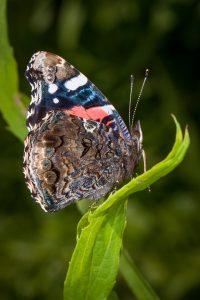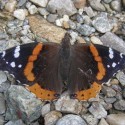
Right now, hundreds of thousands, perhaps millions, of butterflies are fluttering northward. On a sunny day for the last week in northeastern North America, it was impossible not to notice them streaming by or stopping at a flower to fuel up. No, they’re not Monarchs. These are Red Admirals, and about every decade or so, there’s a massive migration northward from somewhere south. It’s one of the many great migrations that often go unnoticed by many people.
Red Admirals (Vanessa atalanta) can’t withstand the north’s harsh winters. Each fall, they migrate south to areas where frost is rare, perhaps venturing as far south as Guatemala. They continue their life cycle during the winter, with as many as four new generations taking flight. When spring comes, they begin migrating northward following the sprouting of their host plants, those found in the nettle (Urticaceae) family.
But about every decade or so, Red Admiral populations explode, bringing a rush of millions of butterflies northward. Scientists believe this could be caused by an unusually mild winter, allowing them to survive farther north and multiply into huge numbers.
This event last occurred in eastern North America in 2012, when record numbers of Red Admirals migrated northward following warm southern wind currents in early spring. Observations were submitted to eButterfly.org (then, just a project in Canada) so rapidly and over such a broad area that we could track the leading edge of the migration in real-time across southern Ontario, Canada. Using observations captured by participants from April 15–17, we estimated that the migrant population was around 300 million individuals migrating over eastern Canada. The estimated migration speed closely matched wind speeds recorded in the region at that time (averaged 26±7 kmh or 16±4 mph).
Twelve years later, it is happening again. Only this time, we are getting e-Butterfly checklists from across the continent.

We could see it coming. In March, checklists submitted from Texas documented enormous counts. On February 8 at the National Butterfly Center in Mission, Texas, butterfly watchers reported 20 admirals in 150 minutes of walking a half mile. On March 2, individuals noted 30 on a 90-minute count covering a 4,000 square-meter garden. And there were many more checklists reporting them in the southern U.S. The pump was primed for a big flight.
Fast-forward to April, and a 60-minute timed count reported 15 Red Admirals in a park in Michigan. On April 14, a 45-minute timed count had 40 in Toronto, Ontario. As more and more reports came in from the upper Midwest by the end of April, the flight was making its way into the Northeast.
On April 28, along the Otter Creek in Salisbury, Vermont, 10 Red Admirals were tallied during a 30-minute count. By the first week of May, they were fluttering through Vermont in big numbers. On May 3, an observer in North Pawlet counted 27 in just 15 minutes. Farther north, in Winooski, a 40-minute count yielded 23 admirals. So far, we have 76 counts shared from across the state, with many more to come on the next sunny day.

They are arriving here just as the nettles are sprouting from the ground; impeccable timing, of course. Observers have seen many of them laying eggs on the fresh plants. If all goes well, these will hatch in five to seven days. The tiny first and second instar caterpillars will form a leaf shelter and feed on the nettle leaves. After about 18 days, they will pupate, emerge, and take flight around nine days later. Overall, they will take about 28 days on average from caterpillar to adult. Here in the northern range, they have two flights. So we can expect at least this first flight in June to be large if all goes well for them.
In late summer or fall, the Red Admirals, many generations removed from their relatives from the south, will embark on a flight southward to destinations unknown to us. How a butterfly that weighs about the same as a paperclip makes the trip is a mystery but not one to be missed.
